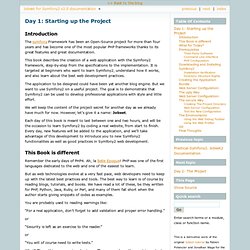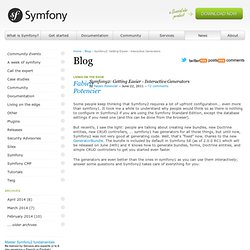

Day 1: Starting up the Project — Jobeet for Symfony2 v2.0 documentation. Introduction The symfony Framework has been an Open-Source project for more than four years and has become one of the most popular PHP frameworks thanks to its great features and great documentation.

This book describes the creation of a web application with the Symfony2 framework, step-by-step from the specifications to the implementation. It is targeted at beginners who want to learn Symfony2, understand how it works, and also learn about the best web development practices. The application to be designed could have been yet another blog engine. But we want to use Symfony2 on a useful project. We will keep the content of the project secret for another day as we already have much for now. Each day of this book is meant to last between one and two hours, and will be the occasion to learn Symfony2 by coding a real website, from start to finish.
This Book is different Remember the early days of PHP4. You are probably used to reading warnings like: or “You will of course need to write tests.” Tip. BUNDLE CREATION. 2: Getting Easier - Interactive Generators. Some people keep thinking that Symfony2 requires a lot of upfront configuration... even more than symfony1.

It took me a while to understand why people would think so as there is nothing to configure in Symfony2 if you are using the Symfony Standard Edition, except the database settings if you need one (and this can be done from the browser). But recently, I saw the light: people are talking about creating new bundles, new Doctrine entities, new CRUD controllers, ... symfony1 has generators for all those things, but until now, Symfony2 was not very good at generating code. Well, that's "fixed" now, thanks to the new GeneratorBundle. The bundle is included by default in Symfony SE (as of 2.0.0 RC1 which will be released on June 24th) and it knows how to generate bundles, forms, Doctrine entities, and simple CRUD controllers to get you started even faster.
The code is quite new and probably comes with a lot of bugs. APC installation. Install APC for PHP on Linux. Posted February 6th, 2008 in PHP (Updated November 5th, 2008) APC is the Alternative PHP Cache, which is a free, open, and robust framework for caching and optimizing PHP intermediate code.

What this means is that APC reads your PHP files, parses them into a more efficient binary format and then caches them in memory so that each request for your PHP files and PHP library files can be fed from the parsed cache. This will generally lead to a speed increase when serving a PHP site, especially one with a lot of library files. This post looks at how to install APC for PHP on Linux. The Linux distribution I used was CentOS 5, but it should be fairly similar for most distros. This article is translated to Serbo-Croatian language by WHGeeks . Download APC from PHP PECL First of all you need to download the APC code from the PHP PECL library. . $ wget This will always get the latest version, and in my case when I installed it just now downloaded APC-3.0.16.tgz like so: $ tar -zxf APC-3.0.16.tgz.